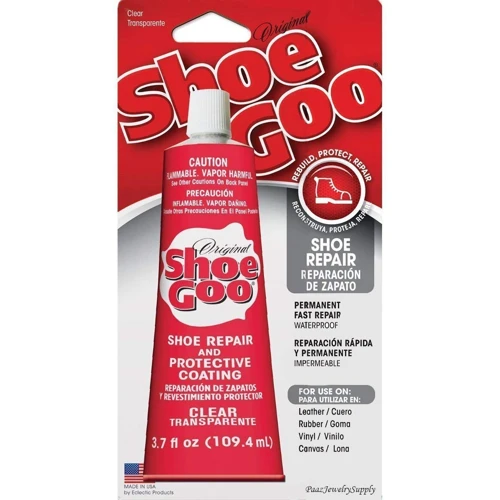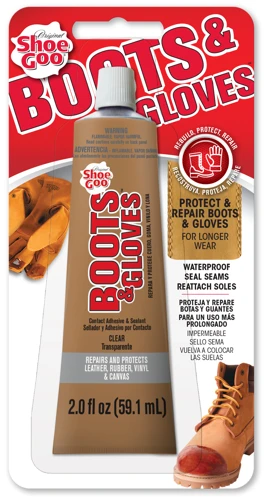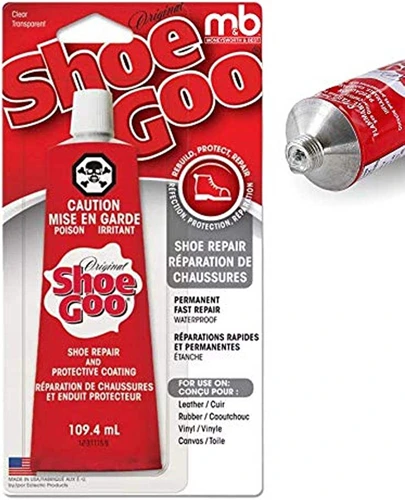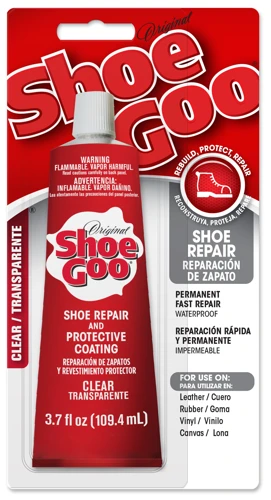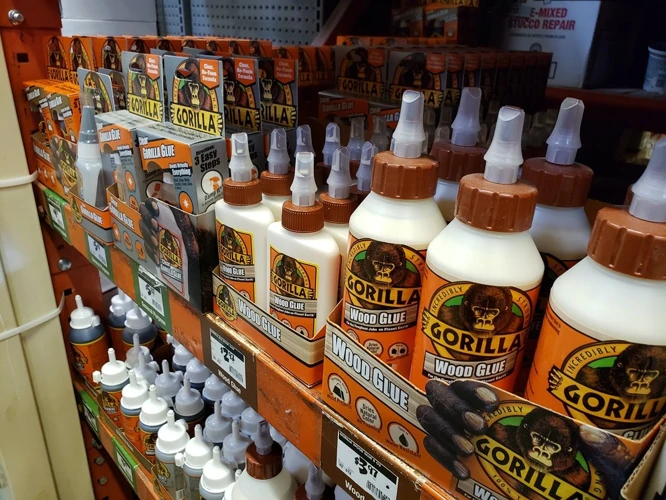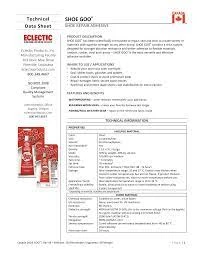As we go about our daily activities, our shoes are bound to experience some wear and tear. The soles may come loose, the seams may unravel, or holes may appear. This can be frustrating, especially if the shoes are still in good condition overall. Instead of discarding them and buying new ones, a more cost-effective solution is to use Shoe Goo glue to give them a new lease on life. But what exactly is Shoe Goo glue? How does it work, and what are its benefits? In this comprehensive guide, we’ll answer all these questions and more. Strap on your strongest pair of shoes and let’s get started!
What Is Shoe Goo Glue?
Shoe Goo Glue is a highly versatile and flexible adhesive with a multitude of applications in both DIY projects and shoe repair. If you have ever wondered how to glue rubber to leather or how to glue a sole back on a boot, then Shoe Goo Glue might be the answer. This unique adhesive has been around for decades and has been used by many to extend the life of their shoes. In this section, we will explore the definition, composition, and history of Shoe Goo Glue and learn how this adhesive works. We will also delve into the various uses and benefits of Shoe Goo Glue and compare it to other types of glue. Finally, we will discuss precautions to take when using Shoe Goo Glue, and look at its storage and shelf life. If you’re interested in learning more about Shoe Goo Glue, keep reading!
Definition and Composition of Shoe Goo Glue
Shoe Goo glue is a versatile adhesive that is specifically designed for the repair and reinforcement of footwear. It is a type of contact adhesive that provides a firm, yet flexible bond that is resistant to impact, vibration, and water.
The composition of Shoe Goo glue consists of a blend of synthetic rubber, thermoplastic elastomers, and other additives that provide different properties to the glue. Synthetic rubber helps the adhesive to bond to the surface whereas additives provide strength and flexibility to the glue.
The chemical composition of Shoe Goo glue is such that it has a strong smell, and it is flammable and volatile. Therefore it should be used in a well-ventilated area, and away from sources of heat and fire.
Moreover, Shoe Goo glue is not meant to be used on all types of materials. It works best on materials like leather, rubber, vinyl, and canvas. It may not work effectively on materials like plastic or metal.
If you need to glue more than two materials, Shoe Goo glue may not be effective. The glue may provide a strong bond between the two surfaces, but it may not be strong enough to hold several materials together.
To get more information on how to glue rubber to leather, you can check out our article on how to glue rubber to leather. Similarly, for more information on how to glue a sole back on a boot, you can head over to our article on how to glue a sole back on a boot.
History of Shoe Goo Glue
The history of Shoe Goo Glue goes back to the 1970s, when a Californian surfer by the name of Lyndon “Spartan” Lambert created a substance to repair his surfboard. He mixed together silicone and fiberglass and found that the resulting compound was effective in patching up damaged surfboards.
Soon after, Lambert realized that his mixture could also be used to fix his worn-out sneakers. He experimented with different proportions of silicone and fiberglass until he found the perfect balance, and Shoe Goo was born.
Initially, Shoe Goo was sold only in surf shops, but its reputation quickly spread, and it became a popular product for repairing all kinds of shoes and boots. Today, Shoe Goo is available in most shoe stores and online shops and is one of the most popular shoe repair products on the market.
Over the years, the formula for Shoe Goo has been refined and improved, and it now contains a blend of polyurethane and silicone elastomers. This combination gives the glue its exceptional adhesive strength, flexibility, and waterproofing properties.
Nowadays, Shoe Goo is not only used for repairing shoes, but also for a wide range of other DIY and outdoor projects, such as fixing broken outdoor gear or sealing leaks in tents and boats.
If you want to learn more about how to use Shoe Goo to repair your shoes or DIY projects, check out our other guides on how to glue leather, how to glue Beats Headband, and how to make shoe glue.
How Does Shoe Goo Work?
Have you ever wondered how Shoe Goo Glue works? This high-performance adhesive is commonly used for repairing and protecting footwear, but what makes it so effective? In this section, we will explore the science behind Shoe Goo Glue and how to apply it properly. Whether you are repairing a leather belt or figuring out how to glue Crocs, this comprehensive guide will provide you with all the information you need. So, let’s dive in and discover the magic behind Shoe Goo Glue!
The Science Behind Shoe Goo Glue
Shoe Goo Glue is an incredibly strong and durable adhesive that is specifically designed for shoe repairs. The science behind Shoe Goo Glue is quite fascinating.
Shoe Goo Glue is made up of a unique formula that combines several chemicals and compounds. The primary ingredient in Shoe Goo Glue is polyurethane, a type of polymer that is known for its flexibility, strength, and durability. Polyurethane is also used in a variety of other applications, including insulation, furniture padding, and packaging.
Shoe Goo Glue also contains several other chemicals, including toluene, which helps to dissolve and blend the other ingredients, and xylene, which helps to clean and dissolve surfaces prior to application. Shoe Goo Glue contains a thickening agent to give it a gooey consistency.
Once Shoe Goo Glue is applied to a surface, it undergoes a chemical reaction known as polymerization. This reaction causes the polyurethane molecules in the glue to cross-link, creating a strong and flexible bond. As the glue dries, the cross-linked polyurethane molecules harden, creating a bond that is nearly impossible to break.
One of the key benefits of Shoe Goo Glue is its ability to adhere to a variety of different surfaces. Whether you need to repair a leather belt or glue together a pair of Crocs, Shoe Goo Glue can get the job done. In fact, Nike even uses a similar type of glue in their shoe production process.
It’s important to note that Shoe Goo Glue should only be used in a well-ventilated area, as the chemicals it contains can be harmful if inhaled. Additionally, once applied, the glue can take up to 24 hours to fully dry and harden, depending on the thickness of the application and the humidity of the surrounding environment.
The science behind Shoe Goo Glue is quite impressive. Its unique formula and cross-linking process make it an incredibly strong and versatile adhesive that is perfect for shoe repairs and a variety of other DIY projects.
How to Apply Shoe Goo Glue?
Shoe Goo Glue can be applied easily and quickly with just a few simple steps. Before applying the glue, it is important to clean and dry the area where the glue will be applied. Here are the steps to follow when using Shoe Goo Glue:
| Step 1: | Squeeze the glue tube to apply a small amount of Shoe Goo Glue onto the surface that needs to be repaired. |
| Step 2: | Use a toothpick or wooden stick to spread the glue evenly over the damaged area. Avoid using fingers as the glue is sticky and can be hard to remove afterwards. |
| Step 3: | Hold or clamp the area together for at least 24 hours to allow the glue to dry and bond effectively. For larger repairs, it may be necessary to use a heavy object or a clamp to hold the area together. |
It is important to note that Shoe Goo Glue dries clear, so it will not leave any noticeable residue on the footwear. Additionally, the drying time may vary based on the size of the affected area and the environment’s humidity. It typically takes around 24 hours for the glue to dry to its full strength.
If you are uncertain about the amount of Shoe Goo Glue required, start with smaller amounts and apply more if necessary. Avoid applying too much Shoe Goo Glue, as it may take longer to dry, and excess adhesive may seep out around the edges and create a mess.
The application of Shoe Goo Glue is a simple process that involves cleaning the affected area, applying the glue evenly, and allowing it to dry for at least 24 hours. With proper use, Shoe Goo Glue can provide an effective and lasting solution for repairing damaged footwear.
Uses of Shoe Goo Glue
Shoe Goo Glue is a versatile adhesive that can solve many of your shoe-related problems. This strong adhesive has been in use for decades and is perfect for a wide range of applications. Whether you need to repair shoes, other types of footwear, or outdoor equipment, Shoe Goo Glue is the perfect solution. So, let’s delve into the many uses of Shoe Goo Glue and explore how it can be used to fix your shoe issues and repair your outdoor gear.
Repairing Shoes and Other Footwear
Shoe Goo glue is well-known for its excellent ability to repair shoes and other types of footwear. It is a popular choice for DIY enthusiasts and professionals alike because it effectively seals and fixes various footwear materials, including leather, canvas, rubber, and more. Whether you have a worn-out sole or a tear on the upper part of your shoe, Shoe Goo can come to the rescue.
Here are some tips on how to repair your shoes and footwear using Shoe Goo:
- Clean the damaged area: Before applying Shoe Goo, make sure the surface you are repairing is clean and dry. Use a damp cloth to remove any dirt or debris. Then let it dry for a few minutes before moving on to the next step.
- Apply Shoe Goo: Squeeze out a small amount of Shoe Goo onto the damaged area. Use a toothpick or a flat object to spread the glue evenly. Be careful not to use too much glue as It can take longer to dry and will cause more mess.
- Press and hold: Squeeze the damaged area together and hold for about five minutes. Make sure the glue is well-distributed throughout the damaged area to ensure excellent adhesion.
- Allow to dry: Once you have finished repairing the damage, allow it to dry for at least 24 to 48 hours before wearing. You can check if the glue is already dry by gently poking it with your finger. If it doesn’t feel tacky, it’s ready to use.
Shoe Goo glue is a game-changer when it comes to fixing a wide range of shoe problems. From repairing soles to patching up tears and cracks, it is a versatile and effective solution for most footwear issues. Keep in mind that when you repair your shoes using Shoe Goo, you’ll add years to their lifespan.
So don’t throw away your expensive shoes just because they have minor damages. Shoe Goo is an excellent investment in the long run and can save you from purchasing an entirely new set of shoes. Just remember to follow proper application techniques for the best results. If you’re looking for more information, check out our article for what glue to use on a leather belt.
DIY Projects
Shoe Goo glue is a versatile adhesive that can be used for repairing and fixing various items, in addition to footwear. The glue’s excellent bonding strength and waterproofing properties make it an ideal solution for DIY projects.
Here are some DIY projects that Shoe Goo adhesive can be used for:
| DIY Project | Description |
|---|---|
| Fixing Tents | If your tent has a hole in it, you can easily fix it with Shoe Goo glue. It is effective in repairing tears and punctures in camping tents and tarps. This will help protect you from the weather elements and the outdoor pests and help you save money as you will not need to replace the tent. |
| Stopping a Leak in a Wetsuit | If you are into diving or snorkeling, you know that one of the most annoying things that can happen is a leak in your wetsuit. Shoe Goo glue can help you to seal small punctures and tears in your wetsuit and keep you warm and comfortable in the water. |
| Making Non-Slip Grips | If you have a slippery phone case or a slippery steering wheel, you can add grip using Shoe Goo glue. Apply a small amount of the glue to the surface and let it dry for 24 hours. The result is a non-slip, easy-to-grip surface. |
| Fixing a Bike Tire | If your bicycle inner tube has a puncture, you can use Shoe Goo adhesive to fix it. Simply clean the area around the puncture, apply a small amount of the glue to the hole, and let it dry overnight before inflating the tire. |
If you want to learn more about other types of glues used in the footwear industry or about Nike’s adhesive, read our What Glue Does Nike Use? article. Also, we have a detailed guide on How to Use E6000 Glue on Shoes if you want to learn more about another type of glue that can be used for fixing shoes. And if you want to know how long does shoe glue take to dry, we’ve got you covered. Finally, if you need to fix your Crocs shoes, read our How to Glue Crocs guide for step-by-step instructions.
Outdoor Equipment Repair
Shoe Goo Glue is not just limited to repairing shoes and other footwear, it can also be used for outdoor equipment repairs. It is a versatile glue that can help repair various types of equipment used outdoors which are prone to wear and tear due to exposure to rough outdoor conditions.
Listed below are some outdoor equipment that can be repaired using Shoe Goo Glue:
- Tents: Tents are an essential piece of equipment for outdoor enthusiasts. However, due to frequent use, they may develop holes or tears. Using Shoe Goo Glue, you can easily repair the tears and holes on your tent and make it usable again.
- Sleeping Bags: Sleeping bags are used for insulation during camping trips. However, they can get ripped or torn while being used. Shoe Goo Glue can help repair the tears and make them good as new again.
- Tarps: Tarps are used to cover equipment or create a shelter when camping. They are also exposed to tough outdoor conditions and can develop holes. With Shoe Goo Glue, you can fix any holes in the tarp and extend its lifespan.
- Hiking Boots: Hiking boots are an essential part of hiking gear, but they tend to wear rapidly due to outdoor conditions. Shoe Goo Glue can fix the worn-out soles and rejuvenate them, making them usable for longer periods of time.
- Camping Chairs: Camping chairs can develop tears or come apart at their joints due to frequent use. Shoe Goo Glue can easily fix such damages and make them as good as new.
Using Shoe Goo Glue for outdoor equipment repairs is a cost-effective option compared to buying new equipment. It requires simple application steps, and the glue dries quickly, making repairs fast and efficient. The glue has waterproofing and weatherproofing properties that prevent further damage due to outdoor exposure.
Benefits of Shoe Goo Glue
Shoe Goo Glue is a versatile adhesive that offers numerous benefits beyond just repairing shoes. Whether you are a DIY enthusiast, outdoor enthusiast, or simply looking for a cost-effective solution for fixing your favorite footwear, Shoe Goo Glue is an excellent choice. In this section, we will explore some of the unique advantages of using Shoe Goo Glue over other types of adhesives. From its flexibility and versatility to its waterproofing and weatherproofing properties, Shoe Goo Glue is a reliable and practical solution for all your bonding needs. Let’s dive in and discover the outstanding benefits that Shoe Goo Glue has to offer.
Cost-Effective
Shoe Goo Glue is one of the most cost-effective solutions for repairing shoes, boots, and other types of footwear. While many types of adhesives may require frequent reapplication or multiple layers of glue to achieve a strong bond, Shoe Goo Glue only needs a small amount to create a long-lasting hold.
One great benefit of Shoe Goo Glue is that it is significantly cheaper than replacing damaged or worn shoes. In fact, it can help you save hundreds of dollars in the long run. Instead of spending a lot of money on a new pair of shoes, you can simply repair the ones you already have using Shoe Goo Glue.
Using Shoe Goo Glue can help you extend the life of your shoes. By fixing a small problem early on with Shoe Goo Glue, you can prevent a bigger issue from forming and keep your shoes in good condition for much longer.
To illustrate the cost-effectiveness of Shoe Goo Glue, compare it to the cost of other types of adhesives. The most popular types of glue on the market include epoxy, super glue, and cyanoacrylate. These adhesives can be used for repairing shoes, but they tend to be more expensive and may not be as effective as Shoe Goo Glue.
In the table below, we compare Shoe Goo Glue to other popular types of glue, and you can see how Shoe Goo Glue is the most cost-effective option:
| Glue Type | Price (per oz.) | Amount Needed for Repair | Total Cost |
|---|---|---|---|
| Shoe Goo Glue | $0.57 | 1-2 drops | $0.57-$1.14 |
| Epoxy | $3.50 | 1-2 drops | $3.50-$7.00 |
| Super Glue | $1.67 | 1-2 drops | $1.67-$3.34 |
| Cyanoacrylate | $1.00 | 1-2 drops | $1.00-$2.00 |
As you can see from the table, Shoe Goo Glue is significantly cheaper than the other types of glue, making it the most cost-effective option. Additionally, you only need a small amount of Shoe Goo Glue to make a repair, which means you can extend the life of your tube of glue, further reducing its overall cost.
If you’re looking for a cost-effective solution for repairing your shoes or other types of footwear, you can’t go wrong with Shoe Goo Glue. Not only is it significantly cheaper than other types of glue, but it’s also a highly effective adhesive that can help you extend the life of your shoes.
Flexibility and Versatility
Shoe Goo Glue is known for its exceptional flexibility and versatility. This adhesive is designed to bond a wide range of materials, including rubber, canvas, leather, vinyl, and many more. The primary reason for the flexibility of this glue lies in its unique composition.
Shoe Goo is made up of a mixture of synthetic rubber and other chemical compounds, which allow the adhesive to flex, bend, and stretch without cracking or breaking. This flexibility makes it an excellent choice for repairing shoes, boots, and other items that need to withstand regular use and movement.
Another significant advantage of Shoe Goo’s flexibility is that it can be used for a wide range of DIY projects, where other types of adhesive may not be suitable. The strength and flexibility of Shoe Goo make it ideal for projects that require bonding materials that are exposed to stress, such as fabrics that will be stretched, twisted, or pulled.
Shoe Goo Glue’s versatility doesn’t end at its flexibility. Because of its ability to bond a wide range of materials, Shoe Goo is an excellent all-purpose adhesive. Its versatility makes it an excellent choice for repairing not only shoes but also other items such as car interiors, sports equipment, and even household items such as furniture or appliances.
Here is an example of the versatility of Shoe Goo Glue in a table format:
| Materials that can be bonded with Shoe Goo Glue: |
|---|
| Leather |
| Canvas |
| Rubber |
| Neoprene |
| Vinyl |
| Plastic |
| Fabric |
| And many more! |
The flexibility and versatility of Shoe Goo Glue make it an exceptional adhesive for various applications. Its unique composition and ability to bond a wide range of materials make it an excellent all-purpose adhesive, and its flexibility ensures a long-lasting bond that can withstand regular use and stress. So, if you’re looking for an adhesive that can handle any task, Shoe Goo Glue is the way to go!
Waterproofing and Weatherproofing Properties
Shoe Goo Glue is known for its impressive waterproofing and weatherproofing properties, which make it an ideal option for repairing and protecting footwear, outdoor gear, and other items that are frequently exposed to moisture and the elements.
Waterproofing properties:
- When applied correctly, Shoe Goo Glue creates a waterproof seal that prevents water from seeping into the repaired area. This is particularly important for footwear that is used in wet environments, such as rain boots or hiking shoes, as it helps to keep the feet dry and comfortable.
- The waterproofing properties of Shoe Goo Glue also make it a great option for repairing leaks in outdoor gear, such as tents, jackets, and backpacks.
Weatherproofing properties:
- In addition to being waterproof, Shoe Goo Glue also has weatherproofing properties that help to protect against other elements, such as wind, snow, and ice. This makes it a popular choice for repairing and protecting winter boots and other cold weather gear.
- The flexible nature of Shoe Goo Glue allows it to expand and contract with the material it is applied to, which helps to prevent cracking and splitting over time. This is particularly important in areas that experience extreme temperatures or weather conditions.
The waterproofing and weatherproofing properties of Shoe Goo Glue make it a versatile and reliable option for repairing and protecting a wide range of items. Whether you’re looking to fix a hole in your rain boots or repair a leak in your camping tent, Shoe Goo Glue has the properties you need to get the job done right.
Shoe Goo Glue vs. Other Types of Glue
When it comes to choosing the right adhesive for your repair or DIY project, it can be confusing to determine which glue to use. Strong adhesives like epoxy, cyanoacrylate (super glue), and construction adhesive are readily available, but how does Shoe Goo glue compare?
Strength: While Shoe Goo glue may not be the strongest adhesive on the market, it is designed specifically for footwear repair, which requires a balance of flexibility and durability. It can withstand the everyday wear and tear of shoes and can be used on a variety of materials such as leather, rubber, vinyl, and canvas.
Drying Time: One of the benefits of Shoe Goo glue is its relatively quick drying time. It typically dries within 24 hours but can vary depending on the thickness of the application. In comparison, super glue can dry in seconds, while epoxy can take several hours to cure.
Flexibility: Shoe Goo glue is designed to remain flexible even after it dries, which is essential for repairing shoes that bend and flex during wear. Other types of glue, such as super glue and epoxy, can become brittle over time and may crack or break when exposed to frequent bending.
Waterproofing: Shoe Goo glue contains a waterproofing agent, making it the perfect adhesive for repairing footwear that may be exposed to water. Epoxy and construction adhesive may also have waterproof properties, but they may not provide the same level of flexibility as Shoe Goo glue.
Application: Shoe Goo glue comes in a tube with an applicator tip, making it easy to apply directly to the surface that needs to be repaired. Super glue and epoxy may require additional tools or mixing before they can be applied.
Shoe Goo glue is a versatile and reliable adhesive that is specifically designed for footwear repair. While other types of glue may have their advantages, Shoe Goo glue offers the right balance of strength, flexibility, drying time, and waterproofing properties for repairing and maintaining footwear.
Precautions When Using Shoe Goo Glue
When using Shoe Goo Glue, it’s important to take certain precautions to ensure your safety and the effectiveness of the product.
Protective Gear: Wearing protective gear such as gloves and goggles is recommended when using Shoe Goo Glue. This will prevent the glue from coming into contact with your skin or eyes.
Ventilation: It’s important to use Shoe Goo Glue in a well-ventilated area. This will help to prevent the inhalation of harmful fumes that may be released during the application process.
Appropriate Surface: Use Shoe Goo Glue only on appropriate surfaces. It’s not recommended to use it on delicate fabrics or materials that may be sensitive to acetone.
Usage frequency: While the product is safe to use, it’s recommended not to use it too frequently as it may cause varying degrees of skin or eye sensitivity or irritation.
Application instructions: Follow the application instructions specified on the packaging to ensure the glue’s effectiveness and safety.
Keep out of reach of children: Shoe Goo Glue is a chemical product that should be kept out of the reach of children.
By following these precautions, you can use Shoe Goo Glue safely and effectively.
Storage and Shelf Life of Shoe Goo Glue
Proper storage and handling of Shoe Goo glue is essential to maintain its effectiveness and extend its shelf life. Storing the glue in a cool, dry place is crucial to prevent it from drying out or hardening before use. Ideally, it should be stored in a temperature-controlled environment away from direct sunlight and moisture.
The shelf life of Shoe Goo glue is approximately two years from the date of manufacture. Once opened, its shelf life can be reduced to a few months. To extend the glue’s life after opening, it should be stored in small airtight containers with minimal air space. This is because the glue reacts with air over time, fouling its formula.
If the glue is stored in the refrigerator, it should be brought to room temperature before use to avoid condensation. When applicable, it may also be a good idea to label the container with the date of purchase or opening to aid in keeping track of its shelf life.
Finally, it’s essential to use Shoe Goo glue as per the instructions provided in the packaging, which will help avoid any damage to your equipment or footwear and create a long-lasting repair. Additionally, it’s recommended to test the glue in an inconspicuous area first to assure its effectiveness.
Frequently Asked Questions (FAQs)
Frequently Asked Questions (FAQs) About Shoe Goo Glue
Are you still confused about what Shoe Goo glue is and how it works? Don’t worry, we’ve got you covered! Here are some frequently asked questions and their answers to help you better understand this versatile adhesive product.
Q: What types of materials can Shoe Goo glue bond?
A: Shoe Goo glue bond a wide range of materials, including rubber, leather, vinyl, canvas, and more. It’s also suitable for use on hard materials like wood, plastic, and metal, making it a versatile choice for many DIY projects and repairs.
Q: How long does it take for Shoe Goo glue to dry?
A: The drying time for Shoe Goo glue can vary depending on the amount applied and the temperature and humidity of the area. Generally, it takes around 24 hours for the glue to dry and fully cure. However, you can speed up the process by using a hairdryer on a low setting or a fan to circulate the air.
Q: Can Shoe Goo glue be used for waterproofing?
A: Yes, Shoe Goo glue has excellent waterproofing properties, making it an ideal choice for repairing shoes and other outdoor gear that may be exposed to water. Once the glue dries and cures, it forms a water-resistant, flexible seal that can withstand rain, mud, and other wet conditions.
Q: Is it safe to use Shoe Goo glue on skin?
A: No, Shoe Goo glue should not be used on skin as it can cause irritation and stick to hair. If you accidentally get the glue on your skin, wash it off immediately with soap and warm water.
Q: How do you remove Shoe Goo glue?
A: Removing Shoe Goo glue can be tricky, especially if it has already dried and cured. One method is to use a solvent like acetone or rubbing alcohol to soften the glue, then carefully scrape it off with a scraper or knife. Alternatively, you can try using a heat gun or hair dryer to soften the glue, then wipe it away with a cloth.
Q: Can you paint over Shoe Goo glue?
A: Yes, once Shoe Goo glue has dried and cured, it can be painted over with acrylic or oil-based paints. However, it’s important to ensure that the glue is completely dry and cured before painting to avoid smudging or cracking.
We hope that these FAQs have helped you to better understand Shoe Goo glue and its various uses. Remember to always follow the instructions on the packaging and take appropriate safety precautions when using this product.
Conclusion
In conclusion, Shoe Goo Glue is a versatile and effective adhesive that has garnered a loyal following among shoe repair enthusiasts and DIY enthusiasts alike. With its unique composition and strong adhesive properties, it offers a cost-effective and convenient solution for repairing shoes and other types of footwear.
One of the standout features of Shoe Goo Glue is its flexible and waterproof nature, allowing it to withstand the wear and tear of everyday use and even extreme outdoor conditions. While it may not be the most aesthetically pleasing option, it certainly gets the job done when it comes to repairing shoes and other types of footwear.
Overall, Shoe Goo Glue is an excellent option for those looking to save money on shoe repairs or for those looking to tackle DIY projects that involve gluing various materials together. However, as with any type of adhesive, it is important to take precautions when using Shoe Goo Glue and to properly store it to ensure it lasts as long as possible.
Whether you’re a shoe repair enthusiast or a DIY enthusiast, Shoe Goo Glue is certainly worth considering as a go-to adhesive for a variety of projects. So, why not give it a try and see the impressive results for yourself?
Frequently Asked Questions
1. Can I use Shoe Goo Glue to repair any type of shoe?
Shoe Goo Glue is ideal for repairing most types of shoes, but it won’t work on shoes made from fabric or suede.
2. Is Shoe Goo Glue waterproof?
Yes, Shoe Goo Glue has excellent waterproofing properties, making it ideal for repairing outdoor shoes and equipment.
3. How long does it take for Shoe Goo Glue to dry?
Shoe Goo Glue can take up to 24 hours to completely dry, depending on the thickness of the applied layer.
4. Does Shoe Goo Glue work on rubber soles?
Yes, Shoe Goo Glue works great on rubber soles and can help extend the life of your favorite shoes.
5. Can I use Shoe Goo Glue to fix a ripped leather jacket?
Yes, Shoe Goo Glue can be used to repair ripped leather garments like jackets and bags.
6. Is Shoe Goo Glue toxic?
No, Shoe Goo Glue is not toxic but it’s always advisable to use it in a well-ventilated area and follow the manufacturer’s instructions.
7. How long will a tube of Shoe Goo Glue last?
One tube of Shoe Goo Glue can be used for multiple projects and can last up to 2 years if stored properly.
8. Can Shoe Goo Glue be used on other outdoor equipment besides shoes?
Yes, apart from shoes, Shoe Goo Glue can also be used on a variety of outdoor equipment for repair, including tents, backpacks, and even surfboards.
9. Can I use Shoe Goo Glue for crafting projects?
Yes, Shoe Goo Glue’s flexible and versatile nature makes it a great option for a range of DIY and crafting projects.
10. Is Shoe Goo Glue better than other shoe repair glues on the market?
Shoe Goo Glue is known for its superior flexibility and waterproofing properties, making it a top choice for shoe repair and outdoor equipment repair.
